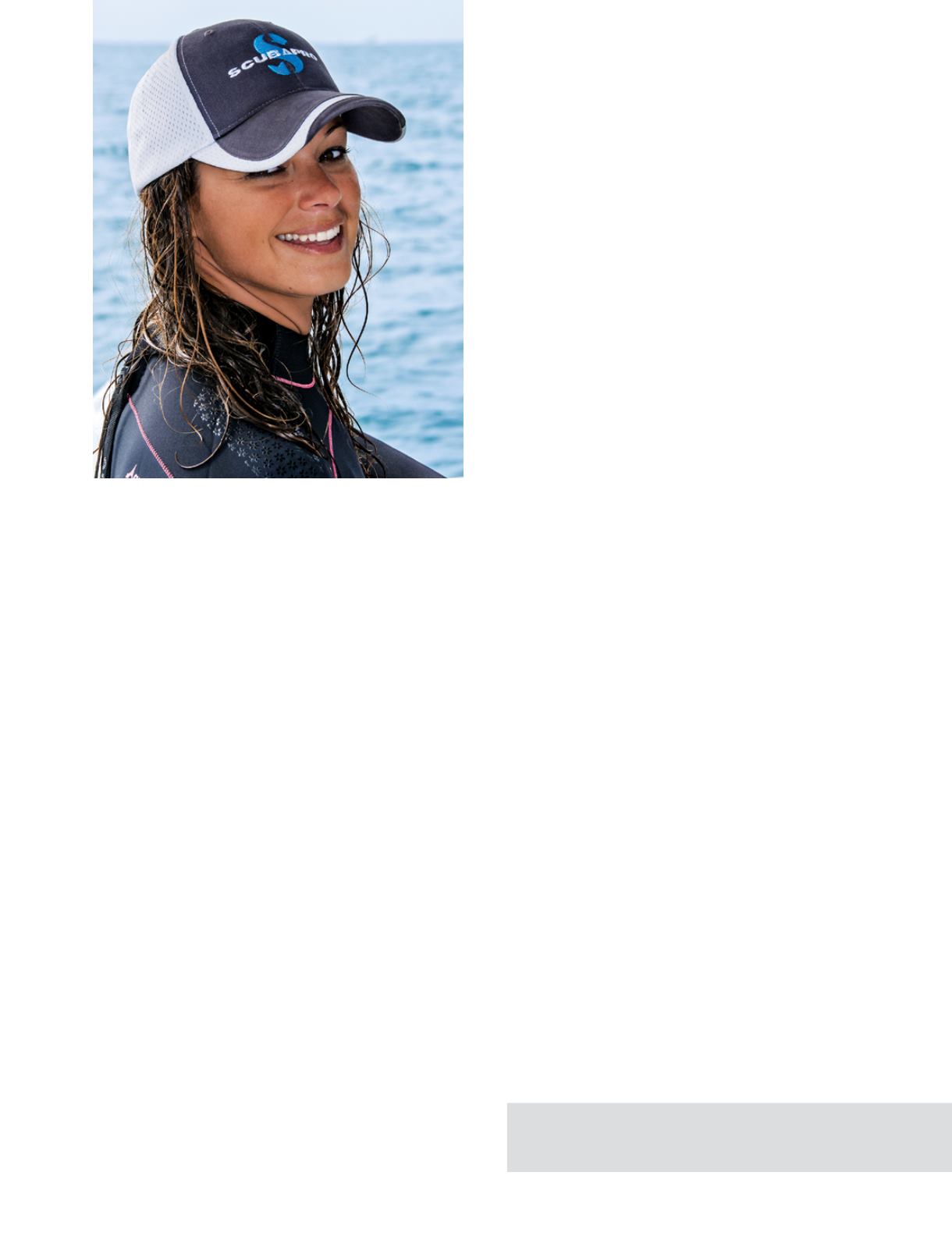
the boat and wait for me there. Four of the eight followed
instructions and patiently awaited my descent.
One buddy team had let go of the line during the weight
check and was now drifting away. Then, as the last pair
entered the water, one of them went into full, active panic —
regulator disregarded, mask thrown, thrashing and climbing
onto me to stay afloat. “I’m going to die! I’m going to die!” he
said over and over. I responded as I was trained to, inflating
his BCD, replacing his regulator and mask, and ensuring we
remained connected to the boat via the tagline.
The struggle on the surface lasted quite a while as the
rescue line was being used for the pair that was drifting down
current. After instructing the two buddy pairs still on the
surface to get back aboard the boat and sit that dive out, I was
finally able to get down to the four divers who were still wait-
ing for me under the boat. Sixteen minutes had passed, and
although I didn’t feel exhausted from the rescue, I now realize
it may have had a significant impact on the rest of my day.
After that dive, the nine of us regrouped for a discussion on
safety protocols and the importance of listening to briefings.
We moved to a new site, and after a short surface interval, I
was ready to splash with seven divers (the diver who panicked
earlier was still sprawled out dramatically across the deck of the
boat). His buddy — who, like him, was 6.5 feet tall and about
300 pounds — soon proved to be an in-water disaster himself.
He had no control over his buoyancy and crashed repeatedly
into our nationally protected coral reef, kicking off obliviously,
too focused on snapping photos and running into other divers.
Despite the fact that he was a foot taller than me and more than
twice my weight, I yanked him off the reef, adjusted his buoyancy
and administered a brief underwater scolding. He rolled his
eyes and headed off in the other direction, breaking off a large
piece of staghorn coral on his way. I turned my head to check
on the rest of the group, and when I turned back the diver was
gone. He had power-inflated himself to the surface.
The diver floundered in a horizontal position, trying to
make air escape from his BCD and ignoring my signs to get
vertical and descend. I surfaced, told him to not leave my
side for the rest of the dive and initiated a controlled descent
onto a sand patch. Moments later, he was back on the
surface. For the rest of his dive he continued racing to the
surface or crashing uncontrollably onto the seafloor while I
continued ascending to help him back down or descending
to lift him off the bottom. Luckily he sucked down all his air
relatively quickly, and instead of surfacing for this “diver”
one last time, I stayed below and watched the rescue line
pull him back to the boat. The rest of the group seemed as
pleased as I was, and we continued our dive.
Forty minutes into the dive, I began to feel a strange pain
at the base of my skull. Something was wrong. I recalled
the divers and signaled it was time to ascend. True to that
group’s nature, two out of the six followed directions, while
the other four looked me in the eye, looked at their gauges
and swam off in the other direction. I surfaced and left those
certified divers to their own devices.
As I climbed the ladder to get back on board, everything
looked strange, as though I was looking out through some-
one else’s eyes. The pain was still pulsing in my head, and
although I wasn’t sure what was going on, I went straight
to the oxygen unit and put the mask to my face. The first
mate was quickly by my side asking questions and handing
me water. That’s about when the tingling began. We called
ahead and arranged for transportation to the hospital to be
waiting for me at the dock.
The hospital was confusing, with different doctors and
nurses coming in and out of my room telling me I was going
for this test and that test. After blood work, a chest X-ray
and a CT scan, they informed me I was going for a chamber
ride — a five-hour U.S. Navy Treatment Table 6. “Is this
really happening?” was the one question that kept coming
to my mind over and over again. My dives had been fairly
shallow, and although there were many ups and downs, all
my ascents to the surface had been slow.
One thing I knew for sure was that DAN® was with me every
step of the way — and DAN has been with me throughout the
aftermath. Nothing is scarier than opening a medical bill that
amounts to more than your annual salary and reading that it
needs to be paid in full by the end of the month. My amazing
representative, Denise Mulkey, talked me off the ledge and
assured me not to worry, that she had my back and that this
would all be taken care of. Without DAN I would have lost
everything simply because I was doing my job.
AD
|
43
SHARE YOUR STORY
Has DAN been there for you? Tell us about it at
.


